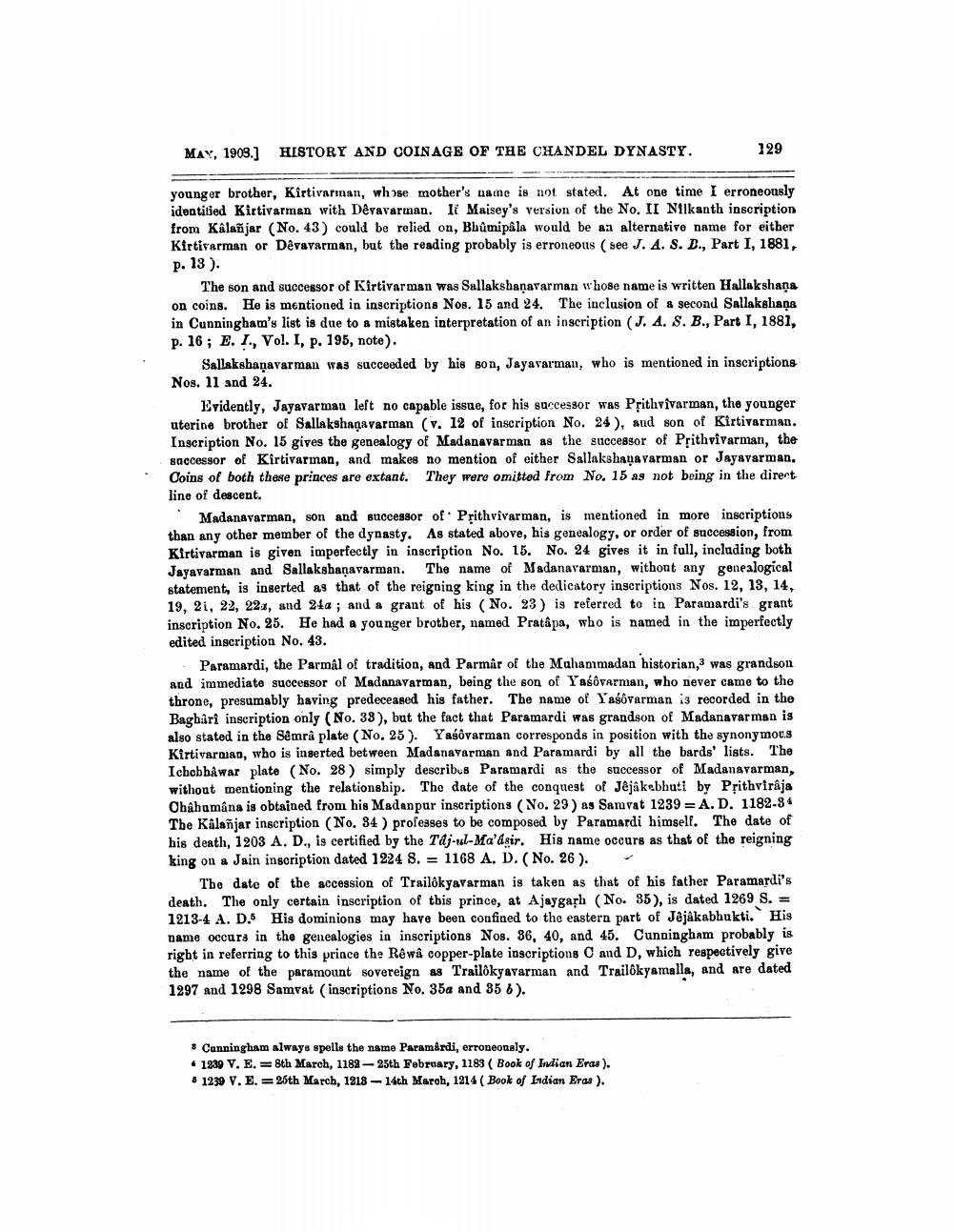________________
MAX. 1903.) HISTORY AND COINAGE OF THE CHANDEL DYNASTY
129
younger brother, Kirtivarman, whose mother's name is not stated. At one time I erroneously identitied Kirtivarman with Dévavarnan. Ii Maisey's version of the No. II Nilkanth inscription from Kalañjar (No. 43) could be relied on, Bhumipala would be an alternative name for either Kirtirarman or Dévavarman, but the reading probably is erroneous (see J. A. S. D., Part I, 1881, p. 13).
The son and successor of Kirtivarman was Sallakshanavarman whose name is written Hallakshana on coins. He is mentioned in inscriptions Nos. 15 and 24. The inclusion of a second Sallakshana in Cunningham's list is due to a mistaken interpretation of an inscription (J. 4. S. B., Part I, 1881, p. 16; E..., Vol. I, p. 195, note).
Sallaksbanavarman was succeeded by his son, Jayavarman, who is mentioned in inscriptions Nos. 11 and 24.
Evidently, Jayavarmau left no capable issue, for his successor was Pșithvivarman, the younger uterine brother of Sallakshanavarman (v. 12 of inscription No. 24 ), and son of Kirtivarman. Inscription No. 15 gives the genealogy of Madanavarman as the successor of Prithvivarman, the saccessor of Kirtivarman, and makes no mention of either Sallakshaṇavarman or Jayavarman, Coins of both these princes are extant. They were omitted from No. 15 as not being in the direct line of descent.
Madanavarman, son and successor of Prithvivarman, is mentioned in more inscriptions than any other member of the dynasty. As stated above, his genealogy, or order of succession, from Kirtivarman is given imperfectly in inscription No. 15. No. 24 gives it in full, including both Jayavarman and Sallakshanavarman. The name of Madanavarman, without any genealogical statement, is inserted as that of the reigning king in the dedicatory inscriptions Nos. 12, 13, 14, 19, 21, 22, 229, and 24a ; and a grant of his (No. 23 ) is referred to in Paramardi's grant inscription No. 25. He had a younger brother, named Pratapa, who is named in the imperfectly edited inscription No. 43.
- Paramardi, the Parmal of tradition, and Parmar of the Muhammadan historian,3 was grandson and immediate successor of Madanavarman, being the son of Yasovarman, who never came to the throne, presumably having predeceased his father. The name of Yaśõvarman is recorded in the Baghiri inscription only (No. 38), but the fact that Paramardi was grandson of Madanavarman is also stated in the Sêmrå plate (No. 25). Yasovarman corresponds in position with the synonymous Kirtiverman, who is inserted between Madanavarman and Paramardi by all the bards' lists. The Ichcbbê war plate (No. 28 ) simply describes Paramardi as the successor of Madanavarman, without mentioning the relationship. The date of the conquest of Jejakebbuti by Prithviraja Ohahamâna is obtained from his Madanpur inscriptions (No. 29 ) as Samvat 1239 = A.D. 1182-34 The Kalañjar inscription (No. 34 ) profeases to be composed by Paramardi himself. The date of his death, 1203 A. D., is certified by the Tdj-ul-Ma'asir. His name occurs as that of the reigning king on a Jain inscription dated 1224 8. = 1168 A. D. (No. 26).
The date of the accession of Trailokyavarman is taken as that of his father Paramardi's death. The only certain inscription of this prince, at Ajaygaph (No. 85), is dated 1269 S. = 1213-4 A. D. His dominions may have been confined to the eastern part of Jejakabhukti. His name occurs in the genealogies in inscriptions Nos. 36, 40, and 45. Cunningham probably is right in referring to this prince the Rêwê copper-plate inscriptions C and D, which respectively give the name of the paramount sovereign as Trailokyavarman and Trailokyamalla, and are dated 1297 and 1298 Samvat (inscriptions No. 35a and 85 6).
* Cunningham always spells the name Paramirdi, erroneously. • 1239 V. E. =8th March, 1182 - 25th February, 1183 ( Book of Indian Eras). • 1239 V. E. = 25th March, 1218 - 14th Marob, 1214 ( Book of Indian Eras).




